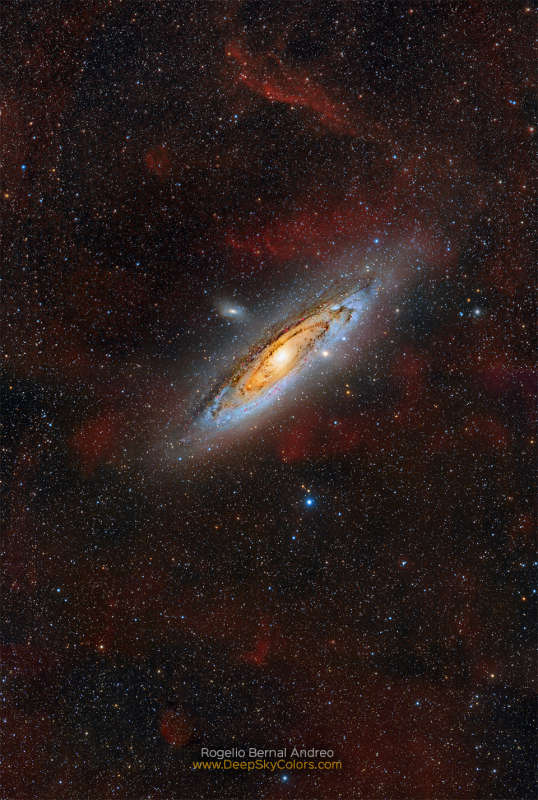Credit & Copyright: Rogelio Bernal
Andreo (Deep Sky Colors)
Explanation:
The beautiful Andromeda Galaxy is often imaged by
planet Earth-based astronomers.
Also known as M31, the nearest large spiral galaxy is a familiar sight
with dark dust lanes, bright yellowish core, and
spiral arms traced by
blue starlight.
A mosaic of well-exposed broad and narrow-band image data, this
colorful,
premier portrait of our
neighboring island universe
offers strikingly unfamiliar
features though, faint reddish clouds of glowing
ionized hydrogen gas in the same wide field of view.
Still, the ionized hydrogen clouds likely
lie in the foreground of the scene, well within our Milky Way Galaxy.
They could be associated with the pervasive, dusty
interstellar cirrus
clouds scattered hundreds of light-years above our own galactic plane.
If they were located at the 2.5 million light-year distance of the
Andromeda Galaxy they would be enormous,
since the Andromeda Galaxy itself is 200,000 or so light-years across.
APOD Lecture: Friday, Jan. 6,
Amateur Astronomers Association of New York City
1999 2000 2001 2002 2003 2004 2005 2006 2007 2008 2009 2010 2011 2012 2013 2014 2015 2016 2017 2018 2019 2020 2021 2022 2023 2024 2025 |
Январь Февраль Март Апрель Май Июнь Июль Август Сентябрь Октябрь Ноябрь Декабрь |
NASA Web Site Statements, Warnings, and Disclaimers
NASA Official: Jay Norris. Specific rights apply.
A service of: LHEA at NASA / GSFC
& Michigan Tech. U.
|
Публикации с ключевыми словами:
M 31 - hydrogen - водород - Туманность Андромеды
Публикации со словами: M 31 - hydrogen - водород - Туманность Андромеды | |
См. также:
Все публикации на ту же тему >> | |
Мнение читателя [1]
